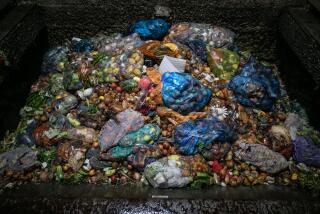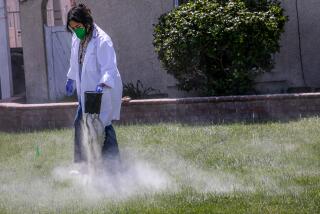Worm Fan Hopes Idea Puts Him on Ground Floor of Sludge-to-Fertilizer Trend
Weldon Platt is into worms. He loves to talk about them, discuss their biochemical makeup, scoop a handful of them into his grasp and, with a little prodding, will gladly delve into their mating habits with clinical detail.
But until he met Ben Price of the Fallbrook Sanitation District, the self-assured 48-year-old Vista worm expert had nothing to show for his knowledge of Lumbricus rubellus but a load of theories and a lot of dirt under his fingernails.
Today, with Price paving the way for him, Platt is ready to turn his worm expertise into an idea that could earn a load of money for the sanitation district and make Platt’s future.
Platt’s plan as project coordinator is to sic thousands of worms on Fallbrook’s sewage sludge, which, after being heated and treated with wood to remove impurities, can be digested by the slimy creatures to make a fertilizer that Platt says will make hundreds of weekend gardeners dance with delight.
With the guidance of Price, who is general manager of the Fallbrook Sanitation District, Platt successfully sold his idea to board members last year. Now, armed with $70,000--which includes his salary and the costs of operation--he’s giving flesh to the plan.
Platt has unleashed 2,000 pounds of worms on the gooey sewage sludge in a remote little valley behind Fallbrook’s sewage treatment plant. The quiet and rustic location adds a veil of mystery to the offbeat idea.
The easygoing Platt loses his calm exterior when he begins speaking in particulars about his plan, which is called vermicomposting--a method of making fertilizer that is used extensively in Europe and Japan but not much here, Platt said.
As he warms to his favorite subject, Platt’s small blue eyes, sunk deep beneath a heavy brow, light up, and he becomes like an excited orator making a profound point.
Platt is dead serious because the bottom line to his plan is money--lots of money.
The district hopes to bring in at least $11,000 in fertilizer sales to nurseries and area farmers in the first year. If the method catches on in other sewage districts, Platt could find himself in the enviable postion of selling his ideas as a consultant.
“I want to make money off this, sure,” Platt said with a sly smile as he rotated chunks of compost filled with valuable worm castings. The castings, Platt said, make a superior fertilizer because of their water retention capability.
“But the beauty of this plan is that the district will be put in a position of getting money from a situation where money was going out the door,” he said.
Platt is referring to the $5,000 a year that the 15,000-customer district spends to dispose of its sewage sludge.
Just like thousands of sewage districts across the nation, Fallbrook has for years subscribed to the time-honored method of disposing of its waste by finding a landfill and dumping the sludge there.
Price always thought this method was a waste and had long been trying to perfect an idea that could incorporate his interests in “resource recycling.”
Though composting sewage and selling it has been done for years, Price had an idea to take this recycling method one step further. But there were pieces missing to the puzzle.
Platt and his worms were the missing pieces, Price said.
“We wanted to convert the wastes into a high-value product for agriculture,” said Price, adding that the worm castings make Fallbrook’s fertilizer superior to ordinary sewage compost.
“I had waited for years to find someone who was interested and capable of making this (recycling process) happen on a full scale,” Price said. “I found that person.”
A physical education and social sciences student in college, Platt has constantly shifted the focus of his occupations as the need dictated. Intending to start out as a teacher, Platt has been everything from administrator in recreation camps to manager of a ranch.
He began raising worms in Oregon and soon began teaching others about the critters as a consultant for worm distributors, who sell them to fish bait stores.
“I started raising them just to help pay for the taxes on my house,” Platt said. “I saw a profit potential in worms, but I didn’t see a lot of real knowledge about them.”
He also didn’t see a lot of money coming his way. Finally, three years ago, Platt took a job at a ranch near Vista, thinking all of his acquired knowledge would be useless.
Dissatisfied with his job, Platt took his resume to Price last year and the connection to Fallbrook’s sewage-sludge proposal was made.
“He came to me and said, ‘Do you think you can point me in the right direction?’ ” Price said. “When I saw his experience with worm farming, I said, ‘Yeah, the right direction is here.’ ”
After formulating the plan and getting the district’s approval, Platt began what has been a one-man operation to make the idea a reality.
Platt and others feel that one of the reasons vermicomposting has not caught on is that the idea is just too simple.
“People trained in the colleges where chemicals are used can’t comprehend this idea . . . The simplicity of using worms is too much for them to understand,” said Jerry Dougherty, who runs Sure Bite Live Bait, a large worm farm in Los Angeles County. “It is used in isolated municipalities around the country, but in many areas it has been rejected.” Platt feels that most sanitation engineers have locked into the idea of chemical disposal and waste-dumping of sewage and refuse to look at other solutions.
“We’re a nation of procrastinators, and unlike in Europe or Japan, we aren’t trained here to look at natural solutions to problems,” Platt said. “We always try to find mechanical ways to fix something.”
For now, Platt is content to go his own way, doing a routine he is sure will catch on.
Begining early in the morning, he takes globs of the pudding-like sewage sludge and mixes it with wood chips to add bulk.
The mixture is then kept at 131 degrees Fahrenheit for three days to remove impurities, after which it is fed to the worms, who feast for 60 days, turning it into high-grade fertilizer.
At full production, Fallbrook could produce a ton of sewage-sludge fertilizer a day, Platt said.
Bill Paznokas, environmental specialist for the state Regional Water Quality Control Board, said Platt’s plan should be approved at the board’s meeting in early June, clearing it for sale to the public.
“The people there in Fallbrook are very conscientious and have a good program,” Paznokas said.
A marketing campaign to sell the fertilizer, which should be out by summer, is to begin next month, Platt said.
The district will probably sell most of the fertilizer to flower nurseries in the area and eventually hire a private contractor to run the business.
Platt doesn’t deny that there is a strong possibility that he could be the private contractor, but for now he’s not going to worry about that.
Confident that he is onto something, Platt just smiles when asked about the future.
“So far, everything has gone exactly as I thought it would,” he said. “I know this is going to work.”






